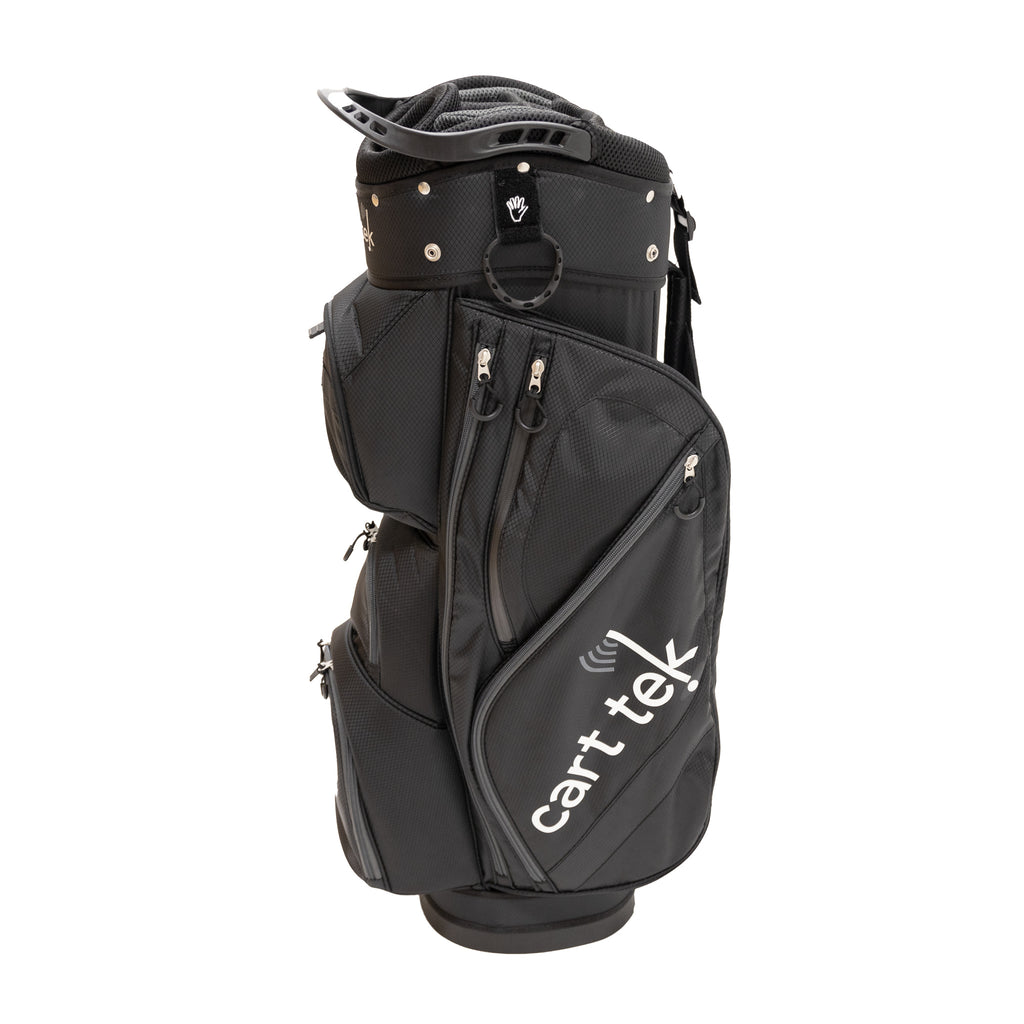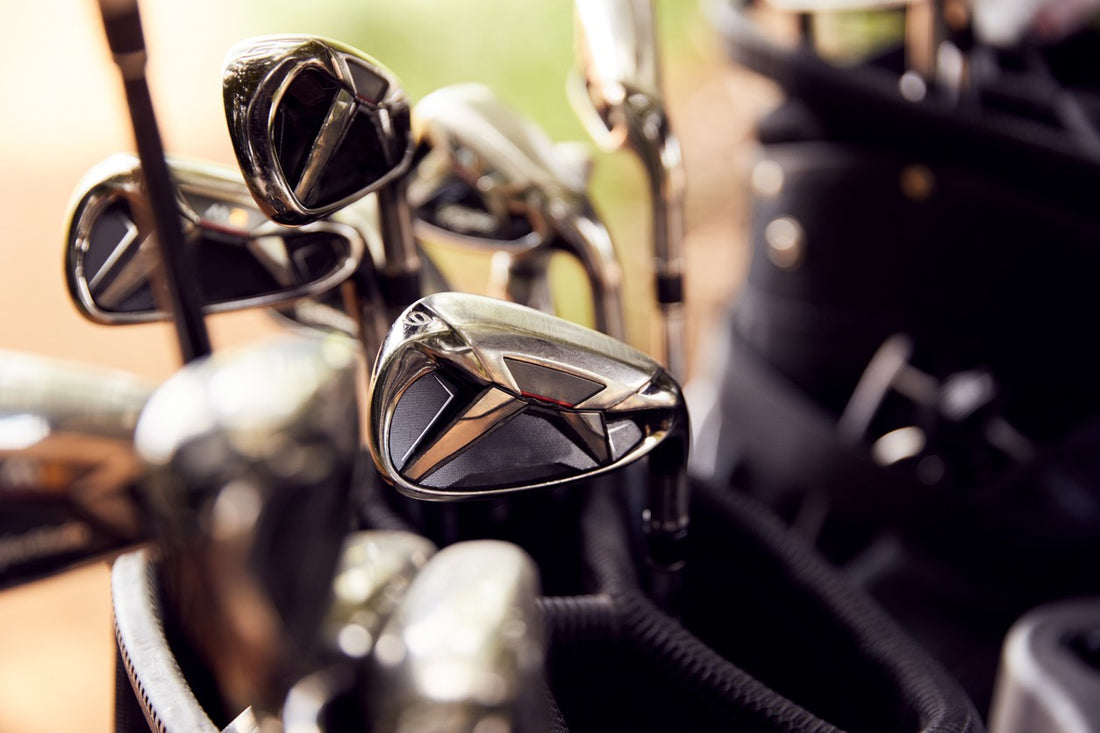Golf is primarily an individualist sport with a long history of style and identity. Players choose their golf equipment from various clubs, bags, and accessories.
Even during the Ryder Cup or the new LIV Series, which embraces team play, players decide on many things, but not the maximum number of clubs they can carry in their golf bag.
Recreational golfers don’t have to worry about how many clubs to carry, but toting a heavy bag is detrimental to your game as fatigue and stress can affect your scores.
No matter how many clubs you carry, using a Cart Tek electric pushcart makes every golf course manageable and a pleasure to follow a golf ball! A professional golfer doesn’t have that luxury. No carts are allowed on the PGA Tour!
Why are only 14 Clubs allowed in a Golf Bag?

The number of clubs used by golfers has varied over the years. Francis Ouimet won the 1913 U.S. Open golf tournament with just nine clubs (seven irons with hickory shafts) in his bag when the average golfer carried 18.
In 1924, the United States Golf Association (USGA) legalized steel shafts. The Royal and Ancient Golf Club of St. Andrews (R&A) followed suit years after the Prince of Wales sported a new set of steel shaft clubs at St. Andrews golf course in 1929.
As steel shafts replaced lighter hickory clubs, caddies paid the price with sore muscles and bad backs because many players insisted on roaming the course with some of each, often totaling twenty or more clubs.
To keep golfers from demanding dozens of clubs and save caddies from compressed discs and premature retirement, the governing bodies USGA and the R&A implemented a complete 14-club rule in 1938.
Today, the rules of golf state a maximum penalty of up to four strokes in stroke play for each club above 14. The loss is capped at two holes or four strokes in match play. No 15th club unless you are switching out a damaged club!
Phil Mickelson had back-to-back months where he caught a two-stroke penalty. But he’s probably forgotten about those infractions from the summer of 2018, especially after becoming the oldest player to win a major by taking the PGA Championship in 2021 at age 50.
Ian Woosnam has probably forgotten his most infamous 2-stroke, but maybe not. During the third round of the 2001 Open Championship (tied for first place), Woosnam noticed an extra club in his bag on the second hole. He had the club removed and, after 18 holes, assessed himself two strokes. The penalty left him tied for third after the final round, a $220,000 error.
What are the Most Common Clubs in a Golf Bag?

When the 14-club rule was enacted, most players carried a 1 to 9 iron, three or four woods, and a single putter. Today, even an experienced golfer might carry some hybrid clubs or an extra wedge with just their 3 to 9 irons since a long iron (1 and 2) is so challenging to play.
Twenty-nine-time PGA event winner Lee Trevino famously said - after being struck by lightning during a round of golf - “I should have carried my one-iron. Even God can’t hit a one iron.”
1. Golf Clubs for Beginners
Most everyone is impressed by a player who can drive a golf ball 300-yards, but a beginner golfer needs to learn to keep their head down as they address the ball and follow through with their swing. They must also be flexible, grip the club correctly, and strike the ball with the sweet spot.
Note that we didn’t talk about specific clubs. That’s because you’ve got to learn your stance and swing before discovering how far your shots go with each club. That means your club selection isn’t that important. Hit your driver or three-wood off the tee, use your irons or hybrids on the fairway, and chip with a wedge to get on the green and putt away!
Don’t spend a ton of money on clubs when you start. Most any set with a driver and a three wood, a hybrid club, and a 5, 7, 9 iron will start you off. Add a pitching wedge, sand wedge, and a putter, and you’ll be ready for the driving range and soon your first round.
2. Golf Clubs for Intermediate Players
Intermediate players have played some rounds, improved their swing speed and accuracy, and know how far to expect their shots to carry with each club strike. That’s great. And that means it might be time for a few more clubs. If you’ve been using a short stack of irons (such as just a 5, 7, 9), filling in the gaps with a 3, 4, 6, and 8 might help your game. You’ll get better at hitting just the proper distance, and your chances of getting up and down in regulation.
Whether you need a 2 or 5 wood or want to add a few hybrids for long shots out of the rough is going to be up to you. Moving up to expensive graphite clubs will also be an option that you may be able to handle (and justify) at this point.
3. Golf Clubs for Professionals
Steel shafts dominate beginner club bags, while graphite is a favorite for some PGA pros. Graphite generates speed but at the cost of accuracy. To get that extra distance produced by adding swing speed, many seniors (pros and amateurs) and LPGA players depend on graphite.
Amateur golfers can be done in by losing their accuracy, while an experienced golfer is more likely to manage the change to graphite.
Professional golfers know their strike distances and want only a tiny gap between clubs. They are more likely to carry four different wedges.
What Does Each Golf Club Do?

While most readers know that a driver is for use off the tee and a putter is used on the green, golf clubs present a little more science. Each club’s face and the loft angle are designed so a player can use the same swing with each club to achieve their desired results.
-
Driver - A driver is used for maximum distance off the tee. A plastic or wooden tee is used because a driver’s sweet spot is higher on the club face than on irons and hybrids.
-
Wood – Golf woods range from 1 to 7, but most golfers carry only a 3 and 5-wood. They are best for narrow fairways off the tee and for fairway shots longer than a player’s usual 3-iron or long hybrid.
-
Iron – Originally cast in iron and hand-crafted, irons are now made of steel or graphite and constitute a bulk of golf shots. Long irons numbered 1 and 2 are no longer used by most players, but irons from 3 to 9 provide specific distances, and most players carry them in their bags.
-
Hybrid – A hybrid is a mix between a wood and an iron, like a 3, 4, or 5-hybrid. Their blade-like face offers the distance of a long iron that can easily break through high rough grass with forgiveness (more prominent sweet spot and accuracy) better than a fairway wood.
-
Wedge – A wedge is used for short distances (usually less than 125 yards) around the green and to blast a ball out of a sand trap.
-
Putter – A putter is the last club used, designed to guide a ball along the green to the cup accurately.
How to Choose Which Clubs to Use in Your Golf Bag

Choosing the right club is as individual as we all are. Still, as mentioned earlier, beginners don’t need to spend a fortune on their first set of clubs. Steel shaft irons of 5, 7, 9, a driver, a 3 and 5-wood, with a sand wedge and a pitching wedge should do you fine.
You might want to spend a little more time using different putter styles, from the stand-up style to mallet heads. Only practice will help you choose.
You’ll need to add extra irons as your skill level increases. Steel shafts are fine, but skilled golfers can go graphite, as can seniors and high handicappers who need the distance because their swing speed has slowed.
The more you learn as a golfer, you’ll likely want an extra wedge. Perhaps a 60-degree lob wedge for a short chip that’s got to get up high and land soft, or a gap wedge with a loft of 49 to 52 degrees for a shot between your pitching and sand wedge distance.
The courses you play may also impact what you choose to carry. Hybrid clubs are great for narrower fairways, thicker roughs and act as a nice mid-iron due to their forgiveness.
Don’t forget that a Cart Tek golf cart bag is a beautiful addition to any set of clubs and offers durability, function, and plenty of easy-access pockets for all your accessories.


